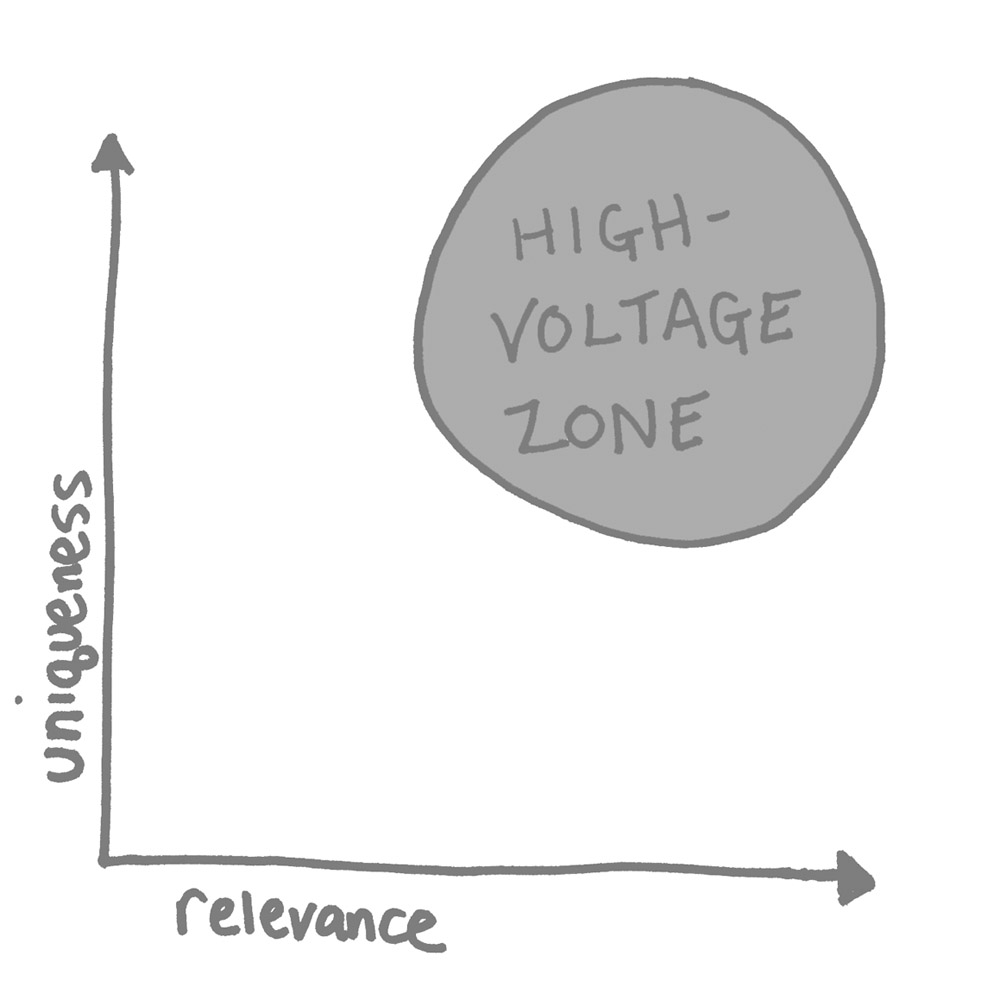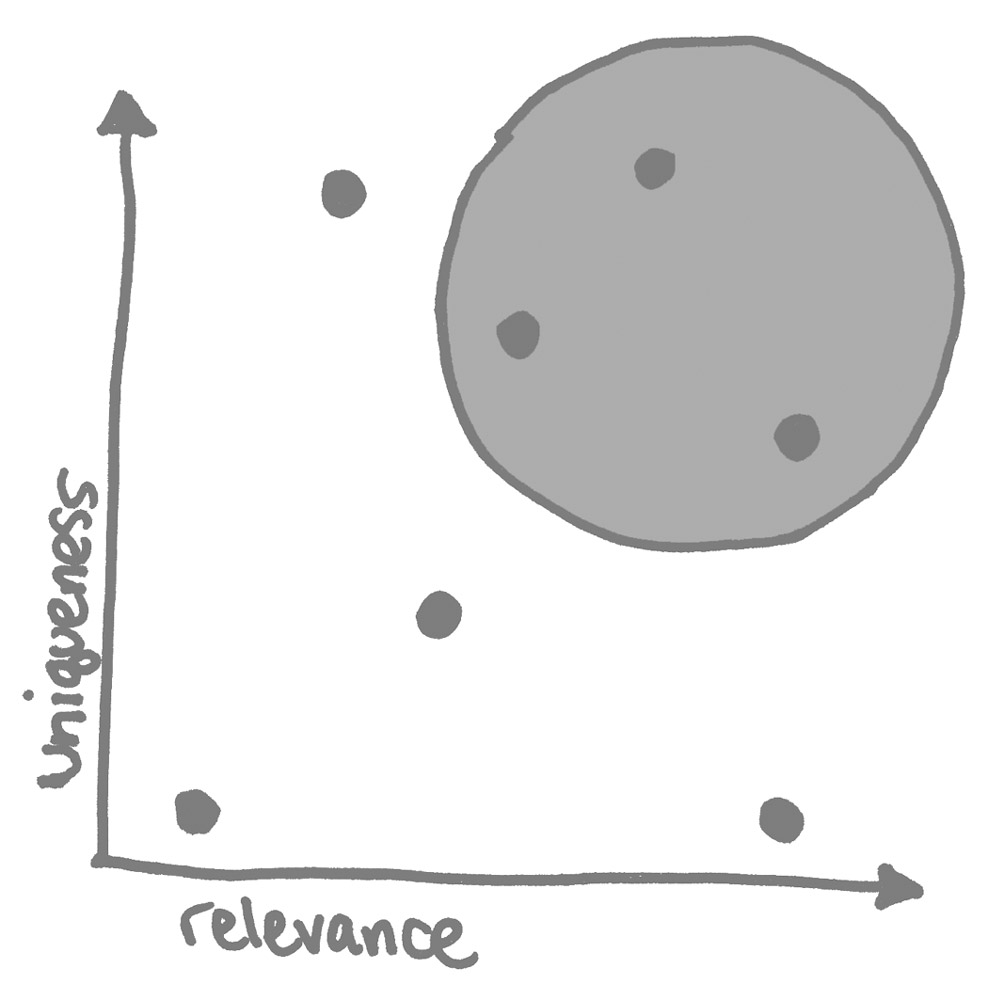Westside Toastmasters is located in Los Angeles and Santa Monica, California
Chapter 7: Measuring The Voltage
Overview
You've made the leap, taken the chances, put yourself out there . . . and now you're reaching the end of the journey of getting in touch with your innate creativity. And yet, it's not so much a journey as a cycle, an experience that you'll have again and again now that you know how. As you generate high-voltage ideas during these cycles of creativity, you need some way to gauge those ideas, to choose among them, to measure their effectiveness before you send them out into the world. That's what this chapter is about.
So, you've been through the journey toward creating a high-voltage idea. You've avoided the enemies of ideas; you've asked questions, identified areas of potential energy, shifted your viewpoint, and generated possible solutions.
Now what?
Now it's time to assess the power of the ideas you've come up with - which of them are high-voltage ideas, and which barely have enough juice to fire up a 40-watt bulb?
In the first chapter, we talked about the zing, the electric charge that a good idea has that springs from a combination of relevance and difference. How do you measure the zing?
Optimal Experience
In my exploration of creativity and the creative process, I've studied the work of Mihaly Csikszentmihaly (pronounced 'chik-SENT-me-high'), especially his theories of optimal experience.
He describes the state of 'flow': the state we are in when we are completely absorbed in what we're doing, when we are unaware of the passage of time, when our abilities are perfectly matched to the task at hand. He created a graph that measures the difficulty of the activity along the x axis and personal skill along the y axis. When difficulty is high and skills are low, frustration results; when skills are high and difficulty is low, you see boredom. But when both skills and ability are high, the subject experiences flow.
I was curious to see if a similar approach could be used to measure the 'voltage' of an idea or a concept.
Instead of skill level and difficulty, I created a graph in which the axes measure the uniqueness of an idea and its relevance. If an idea is very relevant, but doesn't rate very high in uniqueness or difference, then you have consumer boredom: 'I can use it, but so what; it's the same old thing.' If the opposite is true - an idea is distinctive, but it doesn't have a clear application to real life - then we're in 'too crazy for me' territory.
But when an idea is highly relevant and fresh, then the consumer response reaches the high-voltage zone.
Mapping The Response
So, there you are, surrounded by all the ideas that you and your team have generated. The usual post-brainstorming process of going around the room and voting thumbs-up or thumbs-down on each new idea (or dissecting and discussing the life out of each one) puts you in danger of falling back into the logic-versus-energy trap: 'That seems like a good idea, but I know the VP won't see it that way. You had to have been here . . . '
Instead, pinpoint where each idea falls on the voltage graph. On a scale of 1 to 10, how unique or new is the idea? On a scale of 1 to 10, how relevant is it? Does it address the consumer conflict? Is it bringing resolution to a paradox? Then graph your results. Those in the upper left area of the grid will typically be the ideas with the most zing!
When you see the ideas arranged on the graph, it will be clear which ones fall into the zone and which fall by the wayside.
Ask The Experts
When I'm going through this process, I then take the new concepts back to the experts: consumers like the ones I interviewed at the beginning. I give them questionnaires that basically ask, 'Is this idea new, or is it the same old thing?' 'Would you use this every day, or is it ‘just good for camping'?'
This works with moms, with kids, with teens, with 'tweens - anyone you could possibly want to ask. They can tell you, 'Well, my mom would use it, but it's not cool enough for me and my friends,' or, 'My kids would go crazy for it, but it's kind of far out for me.' 'That's interesting.' 'That's wild.' 'That's cool.' 'I've seen that before.' 'BORING!' 'Lame!'
When you've hit the zone, you'll know it. With a high-voltage idea, there's no indifference. 'Oh, well' is banished. There's real excitement as potential energy is released.
With this kind of evaluation, remember that you're dealing with human beings, not with a Geiger counter. It's best not to overload your experts with too many variations on an idea. You want to see how one idea stands or falls on its own merits. Don't fall into the trap of conducting a popularity poll: 'Which of these five ideas is the best?' Comparing ideas is not the same as learning about each one in depth.
Also, don't be too quick to discard ideas that get initial bad responses. Remember the concept of 'never say no.' Your respondent might just be in his or her own analytical mode, telling you that 'that could never work' rather than actually having a personal response ('I hate everything that's lemon-scented, because I'm allergic.') You always want to ask the question, why? A forcefully negative response at least has energy, in contrast to a tepid 'Yeah, it's okay, I guess' response.
Sample Questionnaire For Kids
Idea Name: _____________________ Group #: ________
I'd say this idea is exciting for:
( ) little kids
( ) me
( ) older kids
This idea is:
( ) boring
( ) cool
( ) wacko
The kind of store that would have a program like this is:
( ) nowhere I want to go
( ) where I gotta go
( ) where I'd go if I had to
If I saw this idea on TV, I'd:
( ) pay attention
( ) mute it
( ) change the channel
I could understand this idea:
( ) right away
( ) after I saw the drawings
( ) I still don't get it
Sample Questionnaire For Moms
Idea Name: _____________________ Group #: ________
I'd say this idea is right for:
( ) when I was growing up
( ) my family and my kids
( ) when my kids have kids
My kid would say this idea is:
( ) lame
( ) cool
( ) crazy
This idea is:
( ) creative for creativity's sake
( ) same old, same old
( ) fresh and interesting
This idea seems:
( ) like it would add variety to my routine
( ) boring and mainstream
( ) too far out
Compared to other products I see, this idea is:
( ) way too wacky
( ) same stuff, new name
( ) something different that I actually think I'd like
This makes me think of the manufacturer:
( ) in the same way I always have
( ) as out of its mind
( ) in a fresh, interesting way
The Answers At The Back Of This Resource
Return with me to where this story began: with me, the 'not creative' one, painting a mural on the basement wall, trying to keep up with my sister.
There are always going to be times when each of us is put into a similar situation, whether we believe ourselves to be creative or not. You're handed a brush, put in front of a cement wall, and told to 'do something new,' when all around you it seems as if everyone else has better ideas than you do. Substitute a PowerPoint presentation and a client's conference room for the brush and the basement wall, and I'm sure the setup sounds all too familiar.
This resource is intended to give you a process that you can rely on in those situations. The thing to remember is that this is a process, a series of actions that can lead you to a solution.
When we go through the process, we have to momentarily set aside logic, face our fears, and try to think in a new way, to connect with a different part of ourselves. The concepts that the exercises are based on can be very disconcerting when you're used to thinking in an orderly, sequential way; the way you feel is unfamiliar, different, unquantifiable. You may think, how can I get anything out of this if the end result isn't predetermined? Where are the answers at the back of the book?
Remember that you're not abandoning your left brain; you're just putting it on hold for a moment. The feeling is a bit like swinging out into the void on a trapeze or stepping off the high dive. There are no guardrails. It's a rush of adrenaline - an invigorating or terrifying feeling, depending on your point of view.
But if you go through the process often enough, the feeling will become familiar. You can develop your intuitive side along with your analytical side. You can become used to the idea that although there is a reliable method that you can use, the outcome is different every time. What I hope happens is that you surprise yourself.
Remember the Copernican Shift. Too often, I get the feeling that in other writing on this topic 'experts' and 'authorities' are at the center of their own little universes, flinging out their pronouncements and rules to all the readers who are orbiting them like an asteroid belt.
I'd like you to think of it in the opposite way: You, of course, are at the center. This resource is one of the many things orbiting you, to be useful at the right time and place: when you are blocked by the enemies of ideas; when you need to ask new questions; when you need the jolt of a high-voltage idea.
Exercise
Three-Panel Cartoon
You didn't think you were going to get away so easily, did you? There's one more exercise.
Draw a three-panel (before-during-after) cartoon of your experience with this resource as a whole, especially considering the shift in your feelings about your creativity. Include your thought bubbles and a title for each panel.






